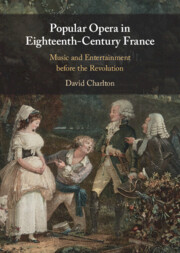Book contents
- Popular Opera in Eighteenth-Century France
- Popular Opera in Eighteenth-Century France
- Copyright page
- Dedication
- Epigraph
- Contents
- Illustrations
- Tables
- Examples
- Preface
- Acknowledgements
- Notes on the Text
- Abbreviations
- 1 Introduction
- 2 Music and Spoken Theatre
- 3 Music in Gherardi’s Company
- 4 Singing and Acting at Home
- 5 Opéra-comique en vaudevilles
- 6 Experiences of Popular Theatre
- 7 Comic and Serious Themes
- 8 Performance as History
- 9 Musical Expansion
- 10 Italian Inroads: The King’s Company
- 11 Six Methods of Synthesis
- 12 A ‘Musico-Dramatic Art’
- 13 Conclusions
- Stage Works Cited
- Bibliography
- Index
12 - A ‘Musico-Dramatic Art’
Published online by Cambridge University Press: 09 December 2021
- Popular Opera in Eighteenth-Century France
- Popular Opera in Eighteenth-Century France
- Copyright page
- Dedication
- Epigraph
- Contents
- Illustrations
- Tables
- Examples
- Preface
- Acknowledgements
- Notes on the Text
- Abbreviations
- 1 Introduction
- 2 Music and Spoken Theatre
- 3 Music in Gherardi’s Company
- 4 Singing and Acting at Home
- 5 Opéra-comique en vaudevilles
- 6 Experiences of Popular Theatre
- 7 Comic and Serious Themes
- 8 Performance as History
- 9 Musical Expansion
- 10 Italian Inroads: The King’s Company
- 11 Six Methods of Synthesis
- 12 A ‘Musico-Dramatic Art’
- 13 Conclusions
- Stage Works Cited
- Bibliography
- Index
Summary
Chapter 12 explains how the French ‘musico-dramatic art’ functioned in practice and how it was theorised. The Introduction accounts for the 1762 merger of the Opéra Comique and Comédie-Italienne, describing the crossroads faced by popular opera. A case study of Le Roi et le fermier (1762) follows, Sedaine and Monsigny’s most ambitious work before Le Déserteur. ‘Politics and Kingship’ traces the origins of its libretto to English tradition: old ballads and Robert Dodsley’s The King and the Miller of Mansfield. Its figure of the monarch and its critique of courtiers are linked to Sedaine’s reworking. ‘The New Art in Action’ sets out Sedaine and Monsigny’s ambitious design, especially the ‘royal hunt and storm’ and overall approaches to musical planning. An analysis by Raphaëlle Legrand explains Sedaine’s techniques from a longer-term perspective. Musical absorption and transmission of political and human aspects is explained, taking in reference to France’s ‘new patriotism’ at the end of the Seven Years War. Theoretical aspects of ‘musico-dramatic art’ articulated by Laurent Garcin, Étienne Framery, Michel-Jean Sedaine and André Grétry are summarised. The importance of Philidor’s music is identified. The ‘Coda’ draws attention to the orchestral and symphonic nature of Philidor’s work and of subsequent popular opera.
Keywords
- Type
- Chapter
- Information
- Popular Opera in Eighteenth-Century FranceMusic and Entertainment before the Revolution, pp. 290 - 309Publisher: Cambridge University PressPrint publication year: 2021



